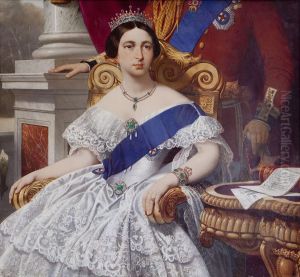Pierre Jules Jollivet Paintings
Pierre Jules Jollivet was a French painter born in 1794 in Paris, France. He was part of the early 19th-century French art movement, and his work primarily focused on genre scenes, portraits, and historical subjects. During a period in art history where Romanticism was giving way to the more realistic approaches of Realism, Jollivet's work was influenced by both of these artistic movements.
Jollivet studied under the tutelage of prominent French artists such as Jacques-Louis David, who was a leading figure in Neoclassical painting, and Antoine-Jean Gros, who was known for his historical and Napoleonic battle scenes. These influences are evident in the classical composition and historical themes seen in Jollivet's works. However, his paintings also reflected the Romantic interest in emotion, individualism, and nature, which was a departure from the strict formality of his teachers' Neoclassical styles.
Throughout his career, Jollivet exhibited his works at the Salon, the official art exhibition of the Académie des Beaux-Arts in Paris. Gaining some recognition for his talent, he produced a number of works that were well-received by critics and the public alike. While he never reached the level of fame as some of his contemporaries, his contributions to the French art scene of the era were nonetheless significant.
Jollivet's paintings often depicted scenes from French history, including moments from the Revolutionary and Napoleonic eras, which were popular subjects during his lifetime. He also painted religious subjects and was known for his skilled portrayal of light and shadow, which gave his works a dramatic quality.
Despite his skills and the quality of his work, Jollivet did not achieve lasting fame, and as a result, he is not as well-known today as some of his contemporaries. He passed away in 1871, leaving behind a body of work that reflects the transitional period of early 19th-century French art. Jollivet's paintings continue to be studied and appreciated by art historians and enthusiasts for their contribution to the development of genre and historical painting in France.







